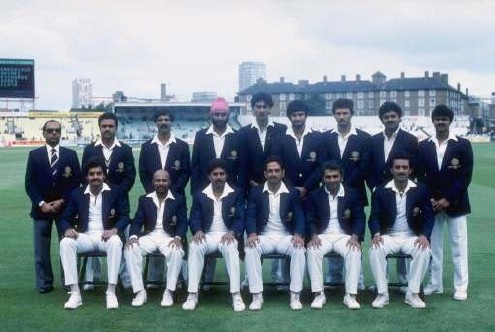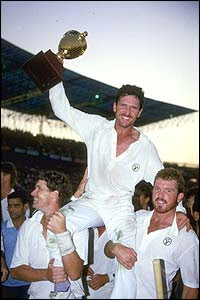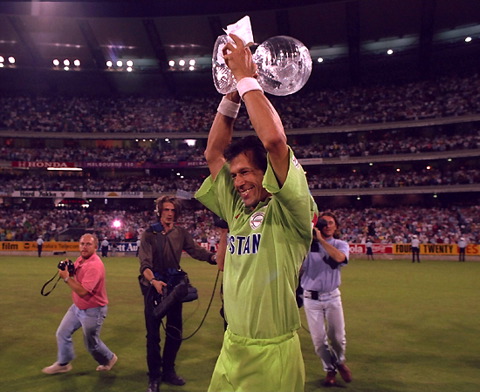With all the T20 leagues across the world and the Ashes victory this past southern hemisphere summer, it seems that what was once the hallmark event for the ICC the One-Day World Cup has some how snuck up on many non-cricketing people, and I must admit that the advertising has been very limited. Which is surprising as it’s the 4th largest World sporting event.
In a two part series I shall look at a brief history of the World Cup, and then prior to the first ball a look into my top 4 sides for the tournament, and the reasons how they can win or lose this years World Cup.
The quality of bowling and batting in the last 4 years has accelerated immensely, and this World Cup is for the first time under threat to holds it own as the preferred trophy amongst the dozen of minor cups and the emergence of the T20 World Cup. This World Cup will also see the end of the road for some of crickets Modern heroes with the likes of Ricky Ponting, Tendulkar, Murali most likely will not be in attendance in 4 years time.
Eight teams participated in the first tournament in 1975 Australia, Pakistan, England, the West Indies,India, and New Zealand, (the six Test nations at the time), together with Sri Lanka and a composite team from East Africa. One notable omission was South Africa, who were banned from international cricket due to apartheid. The tournament was won by the West Indies, who defeated Australia by 17 runs in the final at Lord's.
 |
| 1975 West Indies, first World Cup winners. |
The 1979 World Cup saw the introduction of the ICC Trophy competition to select non-Test playing teams for the World Cup, with Sri Lanka and Canada qualifying. West Indies won a second consecutive World Cup tournament, defeating the hosts, England, by 92 runs in the final. At a meeting which followed the World Cup, the International Cricket Conference agreed to make the competition a quadrennial event.
 |
| Clive Lloyd 1979 West Indies World Cup winners |
The 1983 event was hosted by England for a third consecutive time. By this time, Sri Lanka had become a Test-playing nation, and Zimbabwe qualified through the ICC Trophy. A fielding circle was introduced, 30 yards (27 m) away from the stumps. Four fieldsmen needed to be inside it at all times. India, an outsider quoted at 66-1 to win by bookmakers before the competition began, were crowned champions after upsetting the West Indies by 43 runs in the final.
 |
| 1983 India, a great bet to win at 66-1 odds at the time. |
The 1987 tournament, named the Reliance World Cup after their Indian sponsors, was held in India and Pakistan, the first time that the competition was held outside England. The games were reduced from 60 to 50 overs per innings, the current standard, because of the shorter daylight hours in the Indian subcontinent compared with England's summer. Australia won the championship by defeating England by 7 runs in the final, the closest margin in World Cup final history.
 |
| True Grit, Allan Border lifting the trophy in 1987 |
The 1992 World Cup, held in Australia and New Zealand, introduced many changes to the game, such as coloured clothing, white balls, day/night matches, and an alteration to the fielding restrictions. The South African cricket team participated in the event for the first time, following the fall of the apartheid regime and the end of the international sports boycott. Pakistan overcame a dismal start to emerge as winners, defeating England by 22 runs in the final.
 |
| The Lion of Lahore lifting the trophy 1992 MCG |
The 1996 championship was held in the Indian subcontinent for a second time, with the inclusion of Sri Lanka as host for some of its group stage matches. In the semi-final, Sri Lanka, heading towards a crushing victory over India at Eden Gardens (Calcutta) after their hosts lost eight wickets while scoring 120 runs in pursuit of 254, were awarded victory by default after riots broke out in protest against the Indian performance. Sri Lanka went on to win their maiden championship by defeating Australia by seven wickets in the final, which was held in Lahore.
 |
| 1996 Sri Lanka beating Australia in the final |
In 1999 the event was hosted by England, Australia qualified for the semi-finals after reaching their target in their Super 6 match against South Africa off the final over of the match. They then proceeded to the final with a tied match in the semi-final (also against South Africa) where a mix-up between South African batsmen Lance Klusener and Allan Donald saw Donald drop his bat and stranded mid-pitch to be run out. In the final, Australia dismissed Pakistan for 132 and then reached the target in less than 20 overs, with eight wickets in hand.
 |
| With batsman stranded at each end, the bails off, Australia were champions 1999 |
South Africa, Zimbabwe and Kenya hosted the 2003 World Cup. The number of teams participating in the event increased from twelve to fourteen. Kenya's victories over Sri Lanka and Zimbabwe, among others — and a forfeit by the New Zealand team, which refused to play in Kenya because of security concerns — enabled Kenya to reach the semi-finals, the best result by an associate. In the final, Australia made 359 runs for the loss of two wickets, the largest ever total in a final, defeating India by 125 runs.
 |
| A fresh faced Ponting in 2003 lifting the trophy again for Australia. |
In 2007 the tournament was hosted by the West Indies; the Cricket World Cup became the first such tournament to be hosted on all six populated continents. Bangladesh progressed to the second round for the first time, after defeating India, and they later went on to defeat South Africa in the second round. Ireland making their World Cup debut tied with Zimbabwe and defeated Pakistan to progress to the second round, where they went on to defeating Bangladesh to get promoted to the main ODI table. Australia defeated Sri Lanka in the final by 53 runs (D/L), in farcical light conditions, extending their undefeated run in the World Cup to 29 matches and winning three straight World Cups.
 |
| As the lights went out, the Australians shined winning a third in a row in 2007 |
Australia will be looking to claim a 4th Title in a row, and after knocking over England in such an attacking style it shall be tested once more on Indian soil.While the hosts India have the weight of being the home nation and also as one of the front runners in the tournament on their shoulders, Tendulkar is not getting any younger even if he is getting even better and will be looking to walk away soon. South Africa will like all World Cups enter as a well prepared team outside of the tournament and will see themselves again fighting the tag of ‘chokers’ Sri Lanka will be looking to give stalwart Murali a final sending off in hopefully a home world cup final.
Wednesday next week I shall have complied just in time for the first match on the 19th my Top 4 and the winners and losers from that group.





















